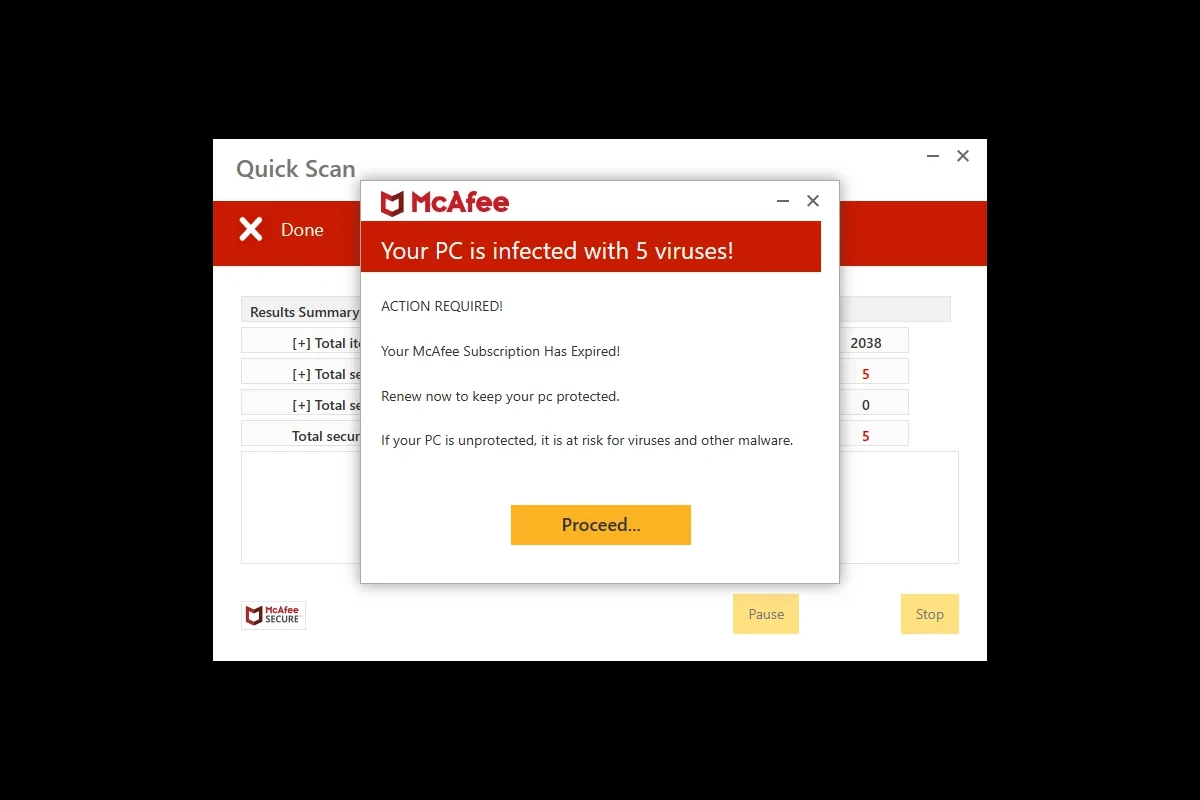Be careful if you see any pop-up notifications claiming that your McAfee subscription has expired as this usually is tied to a pretty widespread scam that has been around for years and years. The clearest giveaway is if you don’t even have McAfee installed or never had a subscription in the first place (it’s hard for a non-existent subscription to expire) but for people that actually do use McAfee, they need to be extra careful. These pop-ups often appear while browsing the internet and can look like genuine warnings from McAfee antivirus software – but in reality, it’s a scammer trying to get you to click on it to then steal information from you, install malware, or for some other nefarious reason.
It’s important to recognize that legitimate McAfee alerts usually come directly from the installed McAfee software itself and not from a browser pop-up. These types of scams are called phishing attempts, which aim to deceive users into providing personal information or making unnecessary payments. When you come across these pop-ups, don’t ever click on them and if you do, don’t ever give them ANY information. If the pop-up was a one-off, it’s usually just the site you were visiting, but if you see them showing up all the time (especially on legitimate sites), then you might have some malware/virus/malicious browser extensions installed causing it.
How to Stop Intrusive McAfee Notifications
“Your McAfee Has Expired” pop-up notifications can be very annoying. It seems like they pop up all the time, and it’s hard to make them stop! Here are a few ways to get rid of these notifications for good.
Block Notifications in Your Web Browser
Most “Your McAfee Has Expired” pop-ups come from your web browser. Here’s how to block notifications in the most popular web browsers:
Google Chrome
- Click the three dots in the top right corner of your browser window.
- Select “Settings”.
- Click “Privacy and security” and then choose “Site Settings”.
- Click “Notifications”.
- Find the website sending the notifications and click the three dots next to its name.
- Select “Block”.
Microsoft Edge
- Click the three dots in the top right corner of your browser window.
- Select “Settings”.
- Click “Cookies and Site Permissions,” and then choose “Notifications”.
- Find the website sending the notifications and click the three dots next to its name.
- Select “Block”.
Safari (Mac)
- Open Safari and go to the “Safari” menu.
- Select “Preferences” and then click the “Websites” tab.
- Choose “Notifications.”
- Find the website listed and select “Deny”.
Uninstall McAfee Software and Extensions
If you are no longer using McAfee software, uninstalling it completely is the best way to get rid of the notifications. Here’s how:
Windows
- Go to your control panel (search for it in the Start Menu if needed).
- Find “Programs and Features” or “Add or Remove Programs”.
- Find McAfee in the list and click “Uninstall”.
Mac
- Search for and open the McAfee removal tool, often located in your Applications folder.
- If you can’t find the removal tool, search for McAfee’s website for instructions.
Additionally, make sure to remove any McAfee extensions from your browser:
- Open your browser’s extension settings (look for a puzzle piece icon or use the three dots to find “More Tools” and then “Extensions”).
- Remove any McAfee extensions.
Use Antivirus Software to Detect Malware
In some cases, “Your McAfee Has Expired” notifications could be a sign of malware. Make sure your device is protected by reputable antivirus software and then run a full scan.
Here’s a table to help you know when and why you might see these pop-up notifications:
| Scenario | Reason |
|---|---|
| You used to have McAfee installed, but it expired. | McAfee software could be partially uninstalled or sending reminders. |
| You didn’t install McAfee, but your computer picked it up. | Your computer may have adware or malware. |
| You are on a website that wants permission to send you notifications. | These could be mistaken for McAfee notifications. |
Key Takeaways
- Pop-up notifications claiming your McAfee subscription has expired are often scams.
- Legitimate McAfee alerts will come from the software, not browser pop-ups.
- Addressing these pop-ups involves checking your McAfee subscription, resetting browser settings, and scanning for malware.
Understanding and Addressing McAfee Pop-up Notifications
Recognizing the difference between legitimate alerts and scam pop-ups is crucial. Adjusting settings can help you manage these notifications. If necessary, you can remove the software to stop these alerts.
Identifying Legitimate Versus Scam Pop-ups
Legitimate McAfee alerts show up in the antivirus program itself. They warn about real security concerns. Scam pop-ups often look similar but appear in web browsers, urging immediate action. They may claim your McAfee subscription has expired and push you to click on a link, leading to fraudulent websites or phishing hazards. Always check the message by opening your actual McAfee antivirus to verify any claims.
Adjusting Notification Settings to Reduce Intrusions
You can limit the number of pop-up notifications from McAfee on Windows. Go to your Windows settings and find the Notifications section. Within this area, you’ll see a list of applications. Find McAfee and switch off the toggle that manages its alerts. This stops pop-up notifications without interfering with your antivirus protection.
Uninstalling Unwanted McAfee Products
Sometimes, you might need to uninstall McAfee products. Go to the Windows Control Panel, look for ‘Programs and Features’, select McAfee from the list, and click ‘Uninstall’. Remove the product following the prompts. If you experience trouble, McAfee provides a removal tool that can help erase all traces of the software.
Managing Browser Extensions and Pop-Up Blockers
To manage unwanted pop-ups in your browser, check for suspicious extensions. In Chrome, type chrome://extensions/ in the address bar. In Firefox, go to the menu, then ‘Add-ons’. Remove any that look suspicious or that you didn’t install. To improve protection, consider adding a reliable ad blocker and pop-up blocker to catch unwanted content.
Enhancing Security to Prevent Malware and Scams
Strengthen security to avoid these pop-up scams. Run regular antivirus scans and keep your software updated. Craft strong passwords and change them if they are weak. Malware can lead to more significant risks such as ransomware. Therefore, alongside using McAfee or another antivirus, be careful with email attachments and links. This dual approach helps recognize and handle any security threats.







